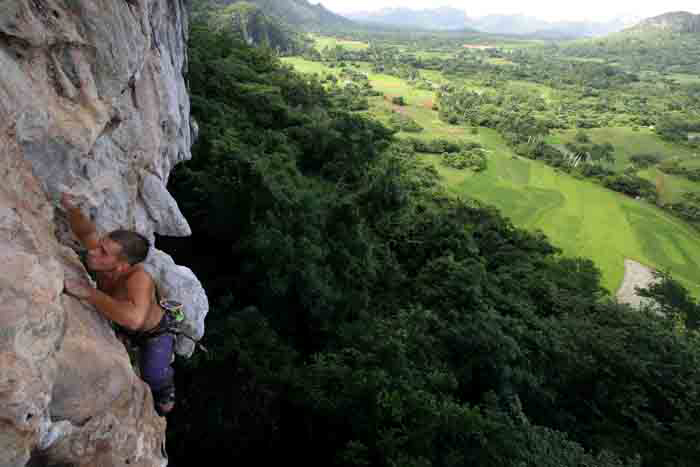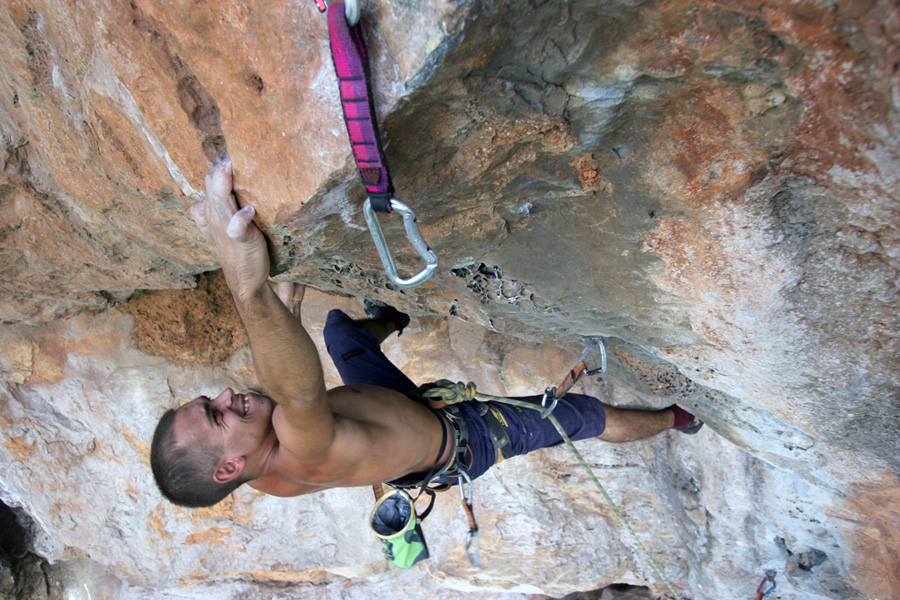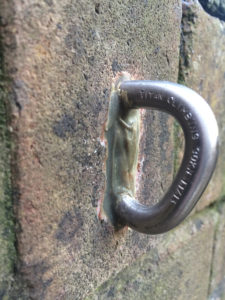Gear Donation
In 1999 four American climbers were the first foreigners to go to Cuba to climb — and bring gear for any Cuban climbers they could find. That has grown into the tradition of foreign climbers leaving their gear and, in time, to a full-fledged donation program run by CubaClimbing.com and supported by a dozen climbing companies to equip and sustain the Cuban climbers.
Bolts4Climbers is another project supporting Cuban climbers, crowdfunding to provide bolts, drills, and hardware for new route development and anchor replacement. As thank-yous for donations, Bolts4Climbers provides items that can’t be bought or found else. There are unpublished topos to new areas in Cuba. For American climbers who are up against a 55 year old failed, cruel, and counterproductive embargo, Bolts4Climbers provides guidelines/itineraries to do a legal climbing trip to Cuba.
Both programs count on visiting climbers to bring the gear and bolts to Cuba. Only the government can import, even donations. Write to CubaClimbing to volunteer.
Together these programs have created a unique situation. Cuba may be the only destination climbing area in the third world where the locals are the primary developers of climbing in their own country and have assumed responsibility for safe and sustainable climbing anchors.
The Cuban climbers are independent of the government and its mega, but controlling sports apparatus. The government has not let climbers form any organization or even maintain a website. It will not import climbing equipment for sale. Cubans have been arrested for climbing. Still, the Cuban climbers persist and grow. There are now Cubans climbers in most provinces. Without the pipeline of donated equipment, climbing could not survive.
There are other ways to help. Pack extra climbing gear and leave it all behind. The majority of visitors now follow the tradition initiated by the first visiting climbers, who left their rack, ropes, shoes and harnesses in Cuba. Try it – you will feel very gratified.
Your gear is valuable, and not just to climbers. Be careful how you donate it. If it doesn’t bother you to see $100 climbing helmets worn by locals on motor scooters or sections of a new rope tied to a horse or ox, then, you may donate your gear as you please.
We strongly urge you to leave your donations only with Armando Menocal (Calle Salvador Cisneron No. 218) or Tito Pimente (Calle Camilo Cienfuegos No. 43). Someone is usually at home at both of these casas. Also you can write to us here for the name and address of where to leave gear in Viñales, Havana, or where else you may be.
Please do not leave climbing gear at the casa you are staying, even one of our recommended casas. Please don’t leave with Cubans who you think are climbers. In either case, do we don’t hear of the donation and probably never get the gear.
The sad really is that the gear climbers bring and give away themselves no longer reaches the climbers who need it. If you donate to the established avenues, CubaClimbing and Bolts4Climbers, the gear will be used for climbing.
Almost all good gear is welcomed and needed. Please, however, no worn out gear or old clothes. It’s so hard to get gear to the Cuba, that it’s a shame to carry ripped, worn shoes and used-up gears. Climbing gyms have been generous, but don’t bring anything from gym rentals and lost-and-found. We can not re-sole soles — resole kits make great donations.
Old ropes and large packs and duffels are exceptions to the no-tattered-gear request. Local climbers help the farmers who permit climbers access to crags with sections of old ropes for their oxen and horses. Gear donated in Viñales goes to climbers all over Cuba. Moving gear around the island requires packs and duffels. Ropes, packs, and duffels will have an easy retirement in Cuba.
Most useful are basics: shoes, harness, ropes, and draws. If wondering Cubans most need, look at your own gear. What have you kept the longest? That’s most likely what previous climbers have also hung onto and not donated. Those include helmets, packs, approach shoes (almost none in Cuba), and personal anchoring set-up (locking biners, daisy chains, long slings, cordelettes). Others? Only 3 or 4 bouldering pads in the entire island. No resole kits at all; soles and cement would be a gold mine.
In clothes, shoes, harnesses, small sizes are best; We don’t know a single Cuban who uses a large harness. There is a great need shoes or harnesses for kids.
More than a dozen companies in the outdoor industry have donated gear since 1999. The companies currently supporting the Cuban climbers are:
BlueWater
Climb X
Black Diamond Equimpent
Exped
Mad Rock
Marmot
prAna
Bolts
No doubt the single biggest need is bolts and hangers. In Cuba, route exploration and development takes power drills and bolts. A single anchor, even if bolts and hangers were available, which they are not, could cost a month’s salary for a Cuban; an entire route, a year’s pay.
The best and most effective way to help climbing in Cuba is to donate through Bolts4Climbers. It buys exactly what is needed, usually at wholesale or even cheaper rates. Bolts, hangers, glue, drills are then taken to Cuba by visiting climbers at no cost and go straight where needed. Bolts4Climbers buys only titanium bolts for new routes and anchor replacement for Viñales and others places in Cuba.
Cuba is a narrow island. All routes are at risk for hidden, stress corrosion failure. Instead of 10 years for failure to appear, as at the popular Costanera wall near Vinales, it may be 20, 25, or 30 years.
All of the other elements for hidden corrosion are everywhere on the island. It is very probable to happen. When it does, the cost in material and labor will exceed all possible volunteer efforts. Imagine a future of bolt-route triage: selecting routes to be rebolted and thus preserved from those to be abandoned, perhaps chopped.
If bringing bolts to donate or to place, please follow these guidelines.
-Bring only the most corrosion resistant bolts and hangers possible. Right now, that metal is titanium.
-Short of titanium, high corrosion resistance (HCR) steels are preferable. Please don’t place any stainless steel in Viñales. You are making the problem worst.
-Bring only glue-in bolts. No expansion bolts. Expansion SS bolts have a place for new routes that must be done ground-up.
-If coming as a visitor, you are not likely to be aware of the options available.
Be sure to let locals know if your bolts are not titanium. They must be monitored for failure, and chopped or eventually replaced.
As of 2018, Cuba reached an important milestone. All of the bolts on the island available for replacement and new routes are titanium glue-ins. In 2019, a great area was developed outside of Holguin in eastern Cuba. More than 30 new routes, and every bolt placed for protection or anchor was titanium bolts.
Please think carefully before you compromise that achievement by bringing steel expansion bolts.
Titanium anchors are not cheap, but are becoming the standard at tropical climbing areas, and a UIAA-certified titanium anchor is now on the market. The principal source is Titan Climbing in the U.K. It’s Eterna Titanium bolt is excellent. The Eterna bolt is also available in the U.S. from RapBolting.com.
Climbers and manufacturers now know that certain factors determine the likelihood of anchor failure. High heat accelerates the rate of corrosion many fold. Moisture, especially water that contains salts, acids from decaying vegetation and in limestone will rust bolts faster, sometimes much faster. Cuba is very hot and very wet, especially in the summer when few climbers visit. Almost all the crags have significant runoff from surrounding vegetation. Most of the cliffs in the Vinales Valley are within 25 miles of the ocean. It’s all karst limestone.
Don’t let its bullet-proof stone fool you, Cuba is the potential perfect storm for bad bolts. In the long run, for bolts in Cuba to be safe for more than a few years will require titanium complete anchors – one-piece glue-ins or complete bolt/hanger combinations.
Anchors of all other metals, from stainless steel to zinc plated, could become a longterm menace. Stainless steel bolts/hanger were the norm in Cuba for 15 years. And now some are failing and dangerous. There are many grades of stainless steel. SAE 304, sometimes called 18/8, is very good in most situations but may not be good enough for use in Cuba. For tropical karst limestone, even marine grade SAE 316 may be insufficient and corrode too quickly.
Most of the carbon-steel bolts, such as the Rawl/Powers 5-piece sleeve bolts, are zinc plated. These bolts are commonly used by climbers in the western U.S. In wet, warm tropical climates, it doesn’t take long for the zinc to corrode. Please, no zinc or galvanized bolts or hangers. These are dangerous in the highly corrosive environment of Cuba.
Finally, please don’t bring or place bolts of different metals, such as an aluminum hanger on a stainless steel bolt. This causes galvanic corrosion and aggressive corrosion.





